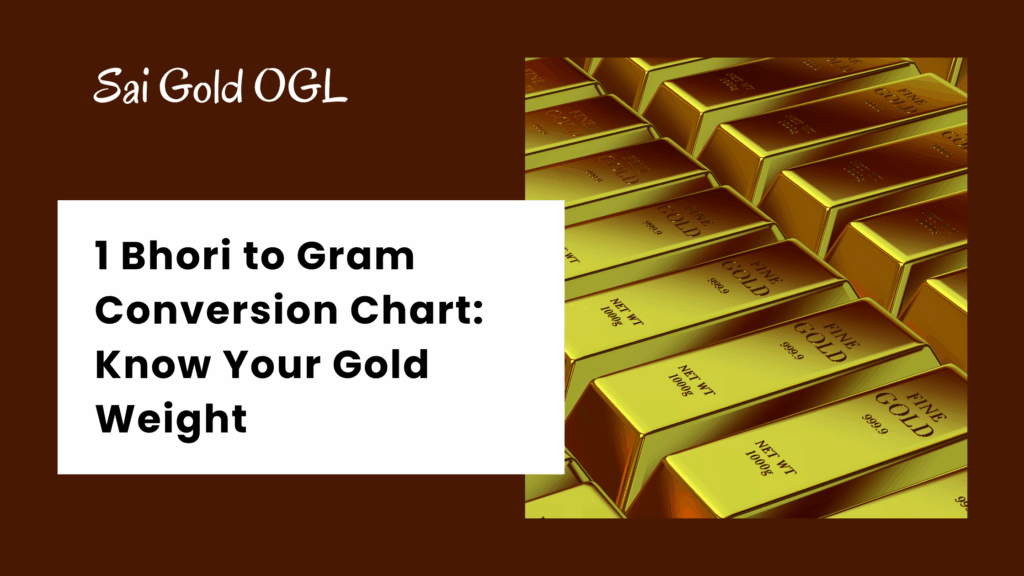If you live in India, Pakistan, Bangladesh, or Nepal, you may have heard the terms Bhori, Tola, Ana, or Ratti being used when discussing gold weight. Out of these, Bhori (or Vori) is one of the most commonly used traditional units—especially in Bangladesh and parts of India and Pakistan. Many people still search for the exact 1 bhori to gram conversion because gold pricing today is based entirely on grams.
For anyone buying, selling, or investing in gold, it’s crucial to understand how these traditional units convert to grams. The modern gold market uses grams as the standard international measurement unit. Therefore, knowing how many grams equal 1 Bhori helps avoid confusion and ensures accurate pricing.
This article gives you a detailed explanation of the 1 Bhori to gram conversion, along with a comprehensive conversion chart, history, uses, and common FAQs.
What is Bhori?
Bhori, sometimes spelled as Vori or Bhori Tola, is a traditional unit of measurement used for gold in South Asian countries. In many places, Bhori is used synonymously with Tola. Although minor regional variations exist, the widely accepted modern equivalent is:
1 Bhori = 1 Tola = 11.664 grams
This standard weight is accepted internationally and used by jewelers and gold markets.
1 Bhori to Gram Conversion
The most accepted conversion is:
1 Bhori = 11.664 grams
This measurement is used today in Bangladesh, India, Pakistan, Nepal, and many Gulf countries when dealing with South Asian gold jewelry buyers.
However, historically, some regions had small variations ranging from 11.30g to 12g, but the modern system of 11.664g is the industry standard.
Bhori to Gram Conversion Chart
Below is a simple, easy to understand conversion chart:
| Bhori (Tola) | Grams (g) |
|---|---|
| 1 Bhori | 11.664 g |
| 2 Bhori | 23.328 g |
| 3 Bhori | 34.992 g |
| 4 Bhori | 46.656 g |
| 5 Bhori | 58.320 g |
| 6 Bhori | 69.984 g |
| 7 Bhori | 81.648 g |
| 8 Bhori | 93.312 g |
| 9 Bhori | 104.976 g |
| 10 Bhori | 116.640 g |
| 20 Bhori | 233.280 g |
| 50 Bhori | 583.200 g |
| 100 Bhori | 1166.400 g |
This chart helps jewelers and buyers quickly estimate the total weight when calculating pricing.
Why Is Bhori Still Used?
Despite the global shift to the metric system, traditional units like Bhori remain popular due to:
1. Cultural Significance
Gold buying is deeply rooted in South Asian traditions. Weddings, festivals, and gifts often refer to gold in Bhori or Tola.
2. Simplicity for Older Generations
Many people, especially elders, still feel more comfortable using traditional units.
3. Market Pricing Convenience
Jewelers often quote large gold quantities in Bhori because it makes pricing discussions easy and familiar.
Using 1 Bhori to Calculate Gold Price in gram
Since gold prices are listed per gram, you must convert Bhori into grams before pricing.
Example Calculation (1 Bhori to Gram)
If gold price = ₹6,000 per gram (or PKR/BDT equivalent)
And you want to calculate price for 5 Bhori:
1 Bhori = 11.664 g
5 Bhori = 5 × 11.664 = 58.32 g
Total price = 58.32 × 6,000
= ₹349,920 (just an example)
This method works regardless of currency—just use the local gold rate per gram.
Bhori vs Tola Are They the Same?
Yes, in most cases Bhori and Tola refer to the same weight.
The standard internationally accepted value:
1 Tola = 11.664 g
1 Bhori = 11.664 g
However, in Bangladesh, the traditional “Vori” used to be slightly different historically, but the market today uses the standard Tola weight.
Where is Bhori Used?
Bhori is primarily used in:
- Bangladesh
- India (especially in eastern & northern regions)
- Pakistan
- Nepal
- Sri Lanka (occasionally)
- Middle Eastern countries serving South Asian customers
It remains popular in gold markets of Dubai, Saudi Arabia, Oman, and Qatar, where expatriates from the Indian subcontinent buy gold frequently.
Historical Significance of Bhori/Tola
The Tola was originally used as a unit of mass in ancient India during the Mughal era. It was based on the weight of a specific number of Ratti seeds—a natural measure used in Vedic times.
- 1 Tola = 180 grains
- Later standardized to 11.664 grams
Because gold was historically weighed in Tolas, the term Bhori became synonymous with gold weight.
Difference Between Gram, Bhori, and Ratti
| Unit | Equivalent Weight |
|---|---|
| 1 Gram | Base unit |
| 1 Bhori/Tola | 11.664 grams |
| 1 Ratti | 0.1215 grams |
Understanding these helps when dealing with antique gold jewelry or ancestral measurements.
Why Use Grams Instead of Bhori Today?
Modern jewellers prefer grams because it is an internationally recognized unit, allows precise purity testing, and makes global pricing easier. For official guidelines on gold purity and hallmarks in India, you can refer to the Bureau of Indian Standards (BIS). Using grams also reduces confusion caused by regional differences, while Bhori remains culturally significant and widely used in daily conversations.
- It is an internationally recognized unit
- Allowed for precision in purity testing
- Makes global pricing easier
- Reduces confusion caused by regional differences
However, Bhori remains culturally significant and is widely used in daily conversations.
If you found this helpful, you might also like our detailed 1 Pavan in Gram guide.
Frequently Asked Questions (FAQs)
There are 11.664 grams in 1 Bhori (or Tola), which is the internationally accepted standard.
Yes, in most regions Bhori and Tola represent the same weight,11.664 grams.
Because of cultural preferences, traditional buying habits, and familiarity among older generations in South Asia.
Convert Bhori to grams (multiply by 11.664), then multiply by the current gold price per gram.
Bhori is mainly used in South Asian countries and Middle Eastern gold markets catering to South Asian customers.







